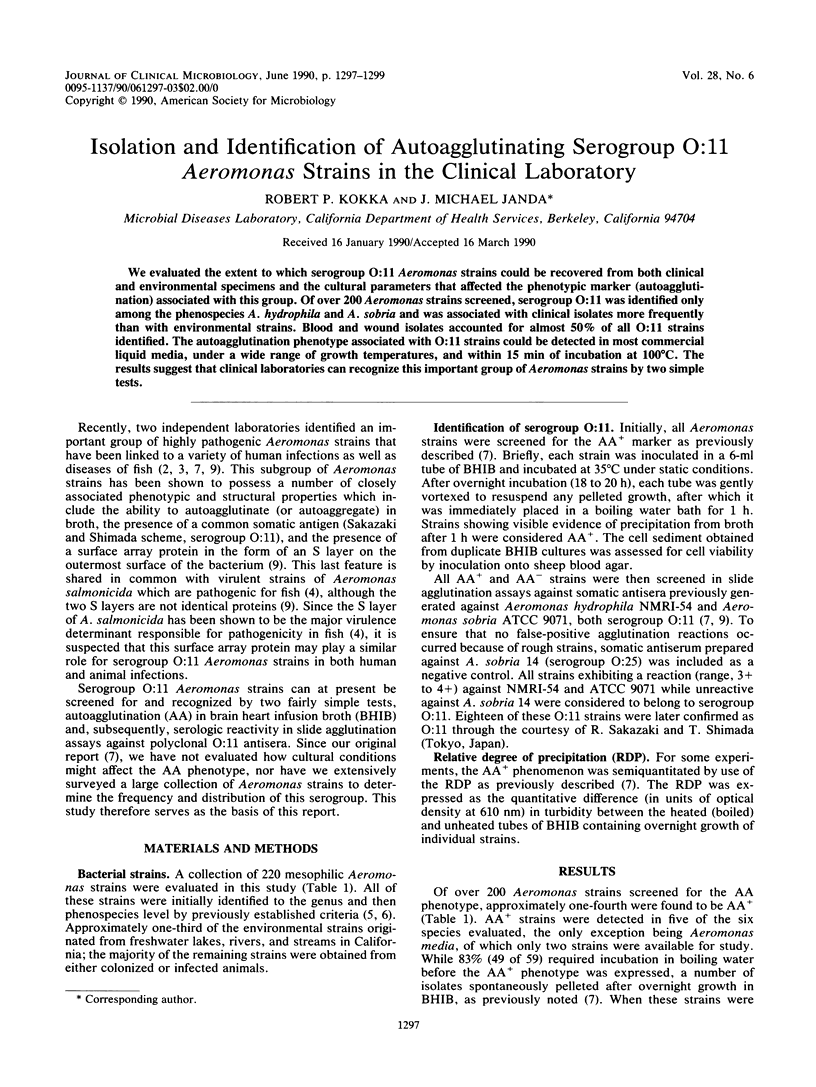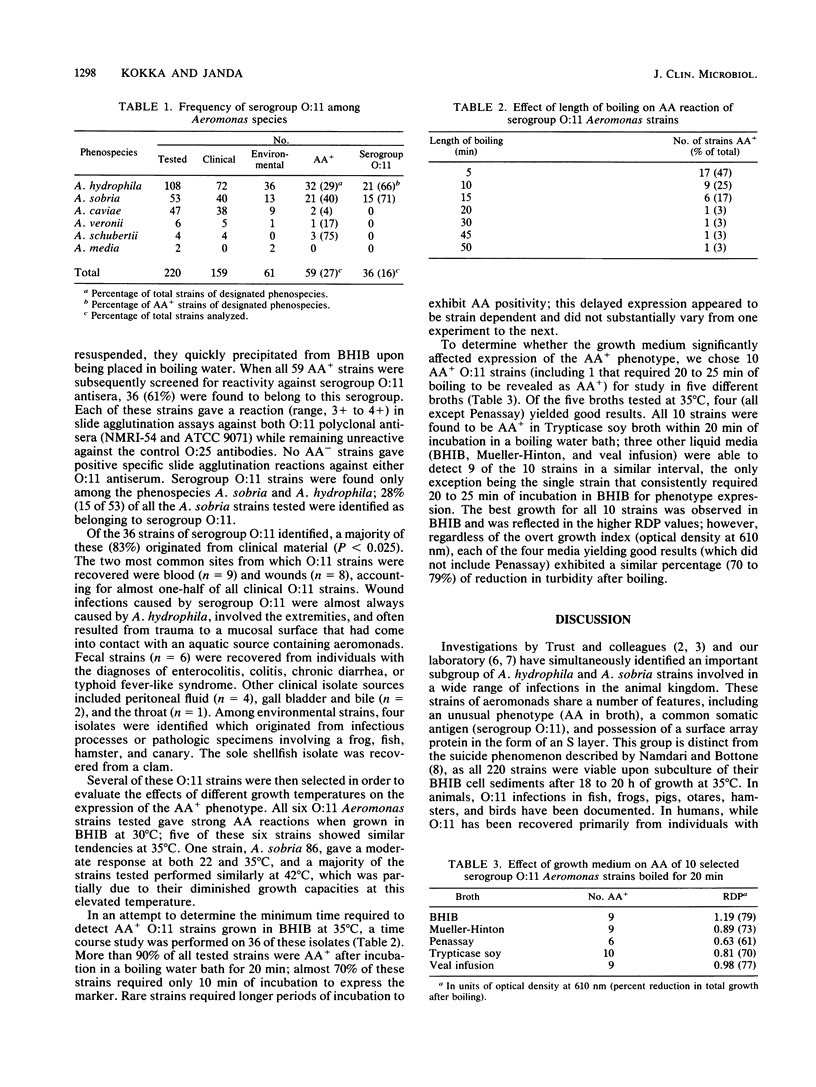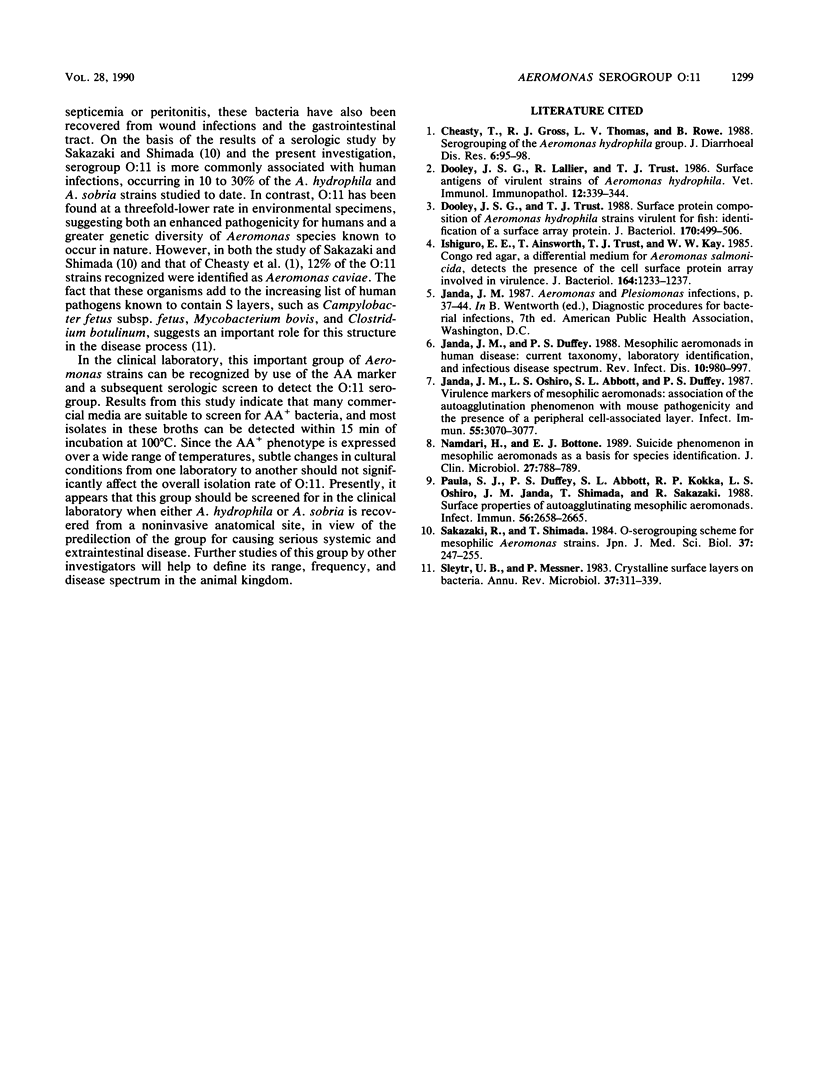Abstract
We evaluated the extent to which serogroup O:11 Aeromonas strains could be recovered from both clinical and environmental specimens and the cultural parameters that affected the phenotypic marker (autoagglutination) associated with this group. Of over 200 Aeromonas strains screened, serogroup O:11 was identified only among the phenospecies A. hydrophila and A. sobria and was associated with clinical isolates more frequently than with environmental strains. Blood and wound isolates accounted for almost 50% of all O:11 strains identified. The autoagglutination phenotype associated with O:11 strains could be detected in most commercial liquid media, under a wide range of growth temperatures, and within 15 min of incubation at 100 degrees C. The results suggest that clinical laboratories can recognize this important group of Aeromonas strains by two simple tests.
Full text
PDF


Selected References
These references are in PubMed. This may not be the complete list of references from this article.
- Cheasty T., Gross R. J., Thomas L. V., Rowe B. Serogrouping of the Aeromonas hydrophila group. J Diarrhoeal Dis Res. 1988 Jun;6(2):95–98. [PubMed] [Google Scholar]
- Dooley J. S., Lallier R., Trust T. J. Surface antigens of virulent strains of Aeromonas hydrophila. Vet Immunol Immunopathol. 1986 Jun;12(1-4):339–344. doi: 10.1016/0165-2427(86)90138-8. [DOI] [PubMed] [Google Scholar]
- Dooley J. S., Trust T. J. Surface protein composition of Aeromonas hydrophila strains virulent for fish: identification of a surface array protein. J Bacteriol. 1988 Feb;170(2):499–506. doi: 10.1128/jb.170.2.499-506.1988. [DOI] [PMC free article] [PubMed] [Google Scholar]
- Ishiguro E. E., Ainsworth T., Trust T. J., Kay W. W. Congo red agar, a differential medium for Aeromonas salmonicida, detects the presence of the cell surface protein array involved in virulence. J Bacteriol. 1985 Dec;164(3):1233–1237. doi: 10.1128/jb.164.3.1233-1237.1985. [DOI] [PMC free article] [PubMed] [Google Scholar]
- Janda J. M., Duffey P. S. Mesophilic aeromonads in human disease: current taxonomy, laboratory identification, and infectious disease spectrum. Rev Infect Dis. 1988 Sep-Oct;10(5):980–997. doi: 10.1093/clinids/10.5.980. [DOI] [PubMed] [Google Scholar]
- Janda J. M., Oshiro L. S., Abbott S. L., Duffey P. S. Virulence markers of mesophilic aeromonads: association of the autoagglutination phenomenon with mouse pathogenicity and the presence of a peripheral cell-associated layer. Infect Immun. 1987 Dec;55(12):3070–3077. doi: 10.1128/iai.55.12.3070-3077.1987. [DOI] [PMC free article] [PubMed] [Google Scholar]
- Namdari H., Bottone E. J. Suicide phenomenon in mesophilic aeromonads as a basis for species identification. J Clin Microbiol. 1989 Apr;27(4):788–789. doi: 10.1128/jcm.27.4.788-789.1989. [DOI] [PMC free article] [PubMed] [Google Scholar]
- Paula S. J., Duffey P. S., Abbott S. L., Kokka R. P., Oshiro L. S., Janda J. M., Shimada T., Sakazaki R. Surface properties of autoagglutinating mesophilic aeromonads. Infect Immun. 1988 Oct;56(10):2658–2665. doi: 10.1128/iai.56.10.2658-2665.1988. [DOI] [PMC free article] [PubMed] [Google Scholar]
- Sakazaki R., Shimada T. O-serogrouping scheme for mesophilic Aeromonas strains. Jpn J Med Sci Biol. 1984 Oct-Dec;37(5-6):247–255. doi: 10.7883/yoken1952.37.247. [DOI] [PubMed] [Google Scholar]
- Sleytr U. B., Messner P. Crystalline surface layers on bacteria. Annu Rev Microbiol. 1983;37:311–339. doi: 10.1146/annurev.mi.37.100183.001523. [DOI] [PubMed] [Google Scholar]


